-
Categories
-
Pharmaceutical Intermediates
-
Active Pharmaceutical Ingredients
-
Food Additives
- Industrial Coatings
- Agrochemicals
- Dyes and Pigments
- Surfactant
- Flavors and Fragrances
- Chemical Reagents
- Catalyst and Auxiliary
- Natural Products
- Inorganic Chemistry
-
Organic Chemistry
-
Biochemical Engineering
- Analytical Chemistry
- Cosmetic Ingredient
-
Pharmaceutical Intermediates
Promotion
ECHEMI Mall
Wholesale
Weekly Price
Exhibition
News
-
Trade Service
Issue scientific opinions on safety
.
After evaluation, the expert panel believes that if the recommended maximum use level of solid food supplements is reduced to the typical use level reported by the applicant, exposure to carbomer will not cause safety problems
.
Some of the original reports are as follows:
.
Some of the original reports are as follows:
The EFSA Panel on Food Additives and Flavourings (FAF) provides a scientific opinion on the safety of crosslinked polyacrylic acid polymers (carbomer) proposed for use as food additive in solid and liquid food supplements.
Carbomer is formed from the monomer, acrylic acid, which is polymerised and crosslinked with allyl pentaerythritol (APE).
The polymers are synthesized in ethyl acetate using ■■■■■ as free-radical polymerisation initiator.
In vivo data showed no evidence for systemic availability or biotransformation of carbomer.
Carbomer does not raise a concern regarding genotoxicity.
Considering the available data set, the Panel derived an acceptable daily intake (ADI) of 190 mg/kg body weight (bw) per day based on a no observed adverse effect level (NOAEL) of 1,500 mg/kg bw per day from a sub-chronic 13-week study in rat, applying a compound specific uncertainty factor (UF) of 8.
At the proposed maximum use levels, the exposure estimates ranged at the mean from 1.
1 to 90.
2 mg/kg bw per day and at the p95 from 12.
5 to 237.
4 mg/kg bw per day.
At the proposed typical use level, the exposure estimates ranged at the mean from 0.
7 to 60.
2 mg/kg bw per day and at the p95 from 10.
3 to 159.
5 mg/kg bw per day.
The Panel noted that the maximum proposed use levels would result in exposure estimates close to or above the ADI.
The Panel also noted that level of exposure to carbomer from its proposed use is likely to be an overestimation.
Taking a conservative approach, the Panel considered that exposure to carbomer would not give rise to a safety concern if the proposed maximum use level for solid food supplements is lowered to the typical use level reported by the applicant.
Carbomer is formed from the monomer, acrylic acid, which is polymerised and crosslinked with allyl pentaerythritol (APE).
The polymers are synthesized in ethyl acetate using ■■■■■ as free-radical polymerisation initiator.
In vivo data showed no evidence for systemic availability or biotransformation of carbomer.
Carbomer does not raise a concern regarding genotoxicity.
Considering the available data set, the Panel derived an acceptable daily intake (ADI) of 190 mg/kg body weight (bw) per day based on a no observed adverse effect level (NOAEL) of 1,500 mg/kg bw per day from a sub-chronic 13-week study in rat, applying a compound specific uncertainty factor (UF) of 8.
At the proposed maximum use levels, the exposure estimates ranged at the mean from 1.
1 to 90.
2 mg/kg bw per day and at the p95 from 12.
5 to 237.
4 mg/kg bw per day.
At the proposed typical use level, the exposure estimates ranged at the mean from 0.
7 to 60.
2 mg/kg bw per day and at the p95 from 10.
3 to 159.
5 mg/kg bw per day.
The Panel noted that the maximum proposed use levels would result in exposure estimates close to or above the ADI.
The Panel also noted that level of exposure to carbomer from its proposed use is likely to be an overestimation.
Taking a conservative approach, the Panel considered that exposure to carbomer would not give rise to a safety concern if the proposed maximum use level for solid food supplements is lowered to the typical use level reported by the applicant.
This article is edited by Foodmate.
com Food Information Center for the reference of netizens.
If you have any questions, please contact news@foodmate.
net
.
com Food Information Center for the reference of netizens.
If you have any questions, please contact news@foodmate.
net
.







